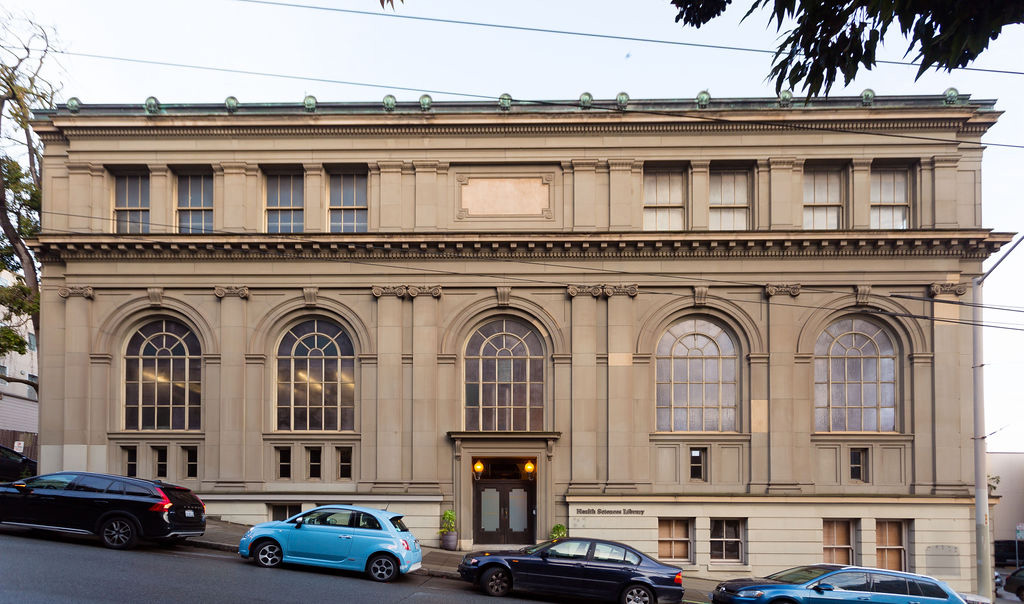
By CHRIS BARNETT
One of the neighborhood’s enduring architectural treasures has been resurrected and a mystery is solved — almost.
The 107-year-old Beaux Arts four-story Health Sciences Library on the corner of Webster and Sacramento — which gave refuge to the smart and studious for decades, but has stood empty collecting cobwebs in recent years — is being reborn as a venue for “mission based” organizations and groups looking for conference and symposium space.
A designated San Francisco landmark once known as the Lane Medical Library, the building at 2395 Sacramento Street is now owned by entrepreneurial software executive-turned-humanitarian Kamal El-Wattar and his wife, Anya, a Michelin-starred chef, restaurateur and wellness advocate. The couple bought it more than two years ago for a reported $9.5 million, but have been silent on their plans for the property. Until now.
Kamal El-Wattar heads a nonprofit called The Answers Project that goes far afield for existential truths. Project researchers once trekked to Borneo to question the elders of an Indonesian culture about their life, philosophy and happiness. He is also a board member of the Biomimicry Institute, a low-to–no-profile think tank of sorts probing how technology and nature can be combined to resolve environmental problems.
Anya El-Wattar is an activist and artist who runs a local nonprofit, Project Butterfly Social, that also creates food events. They live in the neighborhood.
The building has a rich heritage. It was designed in 1912 by San Francisco architect Albert Pissis, who also designed Temple Sherith Israel, which shares the block. The high-ceilinged structure was initially owned by Cooper Medical College, the first medical school in the West, which opened in a Victorian brick building across the street in 1882.

Stanford University acquired the Cooper complex to serve as its medical school from 1908 to 1956, when the Stanford hospital moved to Palo Alto. The complex was then expanded and became the Presbyterian Medical Center. In the early 1990s, it became the California Pacific Medical Center.
For decades, the library was shared by students at the University of the Pacific’s dental school, then located diagonally across from the library. Students used the library as a reading room and study hall until the dental school relocated downtown five years ago. Its neighborhood home was gutted and converted into The Pacific, a 77-unit condominium complex at Webster and Sacramento.
To help bring the library back to life, the El-Wattars hired a Washington, D.C., firm, Bond Events, to produce gatherings. The grandly stated mission: to make the century-old building the Bay Area’s go-to spot to “grow, meet, learn, discover and make history.”
A website shows off the space and the firm’s promotional prowess. The library, once filled with shelves and stacks piled high with musty books and instructional videos, today looks positively palatial, with a wide, sweeping staircase connecting its main floors.
Bond Event marketing director Kate Starr says a separate ground floor gallery space is ideal for “art shows, gatherings and fundraisings.” The second floor, with its large open space that was formerly the reading room, is called The Library. The third floor has meeting and breakout spaces and the fourth floor will have offices for the owners’ nonprofit ventures. The building also has an outdoor garden.
“We are committed to creating flexible space that helps heal our bodies, our minds and the planet,” the website proclaims.
It appears the building is not going to compete head to head with the city’s hotel ballrooms and meetings spaces. “We will have limited social events,” says Starr. Revenue the library generates will be used to support the needs of the El-Wattars’ foundation, she says.
EARLIER: “Medical library is on the block“
Filed under: Landmarks




